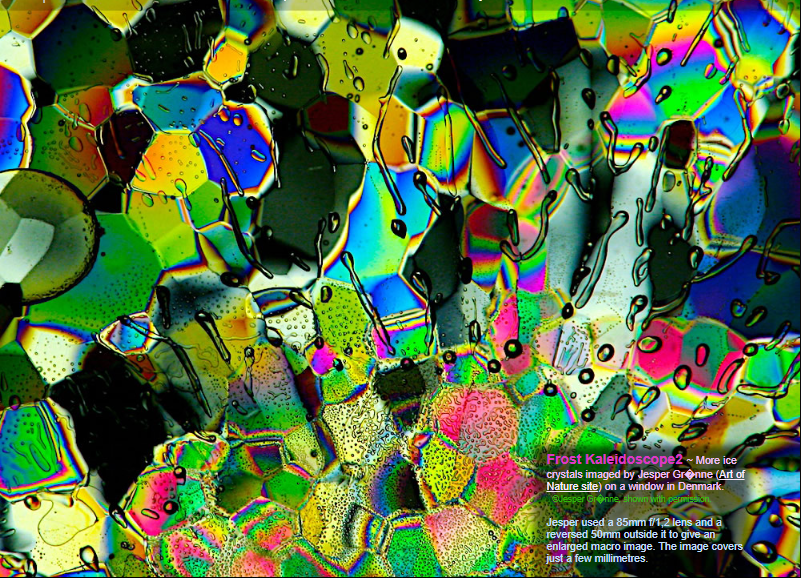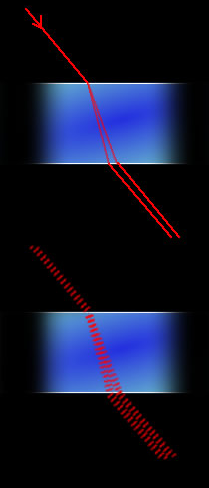Frost kaleidoscope2
Frost Kaleidoscope2: Unveiling the Magic of Ice Crystals
Welcome to the enchanting world of frost kaleidoscope2! In this mesmerizing display of nature's artistry, Jesper Grønne captures the beauty of ice crystals on a window in Denmark. With his expert photography skills, Jesper reveals the hidden secrets of these intricate formations. Let's delve deeper into the science behind the magical colors and captivating patterns seen in frost kaleidoscope2.
The Lens and Technique Behind the Macro Image
Jesper Grønne utilized an 85mm f/1.2 lens combined with a reversed 50mm lens to capture an enlarged macro image of the frost crystals. By employing this technique, he was able to focus on just a few millimeters of the frost's surface, highlighting its intricate details. This unique perspective allows us to witness the delicate beauty of each individual ice crystal.
The Role of Polarizing Filters in Unveiling Colors
The secret to the vibrant colors seen in frost kaleidoscope2 lies in the use of polarizing filters. Ice crystals are birefringent, meaning they have double refractive properties. By placing a polarizing filter on each side of the crystals, Jesper reveals the colors resulting from interference between the two differently polarized rays produced by birefringence. This technique uncovers a world of hues that would otherwise remain hidden to the naked eye.
Distinguishing Between Birefringent and Thin Film Colors
Not all colors in frost kaleidoscope2 are solely a result of birefringence. Thin film interference also plays a role in creating the captivating palette of colors. To differentiate between the two, Jesper recommends rotating the camera polarizer. When the camera polarizer is rotated, the birefringent colors change, while those produced by thin films remain relatively stable. This allows us to appreciate the distinct contributions of both phenomena to the kaleidoscopic display.
The Fascinating Behavior of Light within Frost Crystals
As light passes through a frost crystal, it undergoes a mesmerizing transformation. The refracted ray splits into two components with different polarizations. These emerging waves possess a phase difference due to their varied path lengths through the ice. The interaction between these waves results in interference, which gives rise to the vibrant colors we observe. The phase differences are wavelength dependent, explaining the diverse hues that dance within frost kaleidoscope2.
Exploring Jesper's Earlier Ice Images
Jesper Grønne's earlier ice images offer further insight into the captivating world of frost kaleidoscope2. These images, along with frost kaleidoscope2, provide a comprehensive view of the diverse formations and colors that can be observed within ice crystals. Each photograph showcases the unique beauty and complexity of nature's frozen artistry.
Embracing the Magic of Frost Kaleidoscope2
Frost kaleidoscope2 is a testament to the intricate wonders that can be found in even the simplest of natural phenomena. By delving into the science behind these captivating images, we gain a deeper appreciation for the magic that lies within ice crystals. Let Jesper Grønne's stunning photography serve as a reminder to pause and marvel at the hidden beauty that surrounds us, waiting to be discovered.

Frost Kaleidoscope2 ~ More ice crystals imaged by Jesper Gr�nne (Art of Nature site) on a window in Denmark. ©Jesper Gr�nne, shown with permission.
Jesper used a 85mm f/1,2 lens and a reversed 50mm outside it to give an enlarged macro image. The image covers just a few millimetres.
The secret of the magical colours is that he imaged the frost between two crossed polarising filters.
Ice is birefringent or double refracting. Placing a polarising filter each side of the crystals reveals colours from interference between the two differently polarised rays resulting from the birefringence.
Colours are also produced by thin film interference. Distinguish between them by rotating the camera polariser. Birefringent colours then change while those from thin films hardly do so.
Jesper's earlier ice images 1,2,3,4

Rays through a frost crystal
Ice is birefringent. The refracted ray splits into two components with different polarisation.
The emerging waves have a phase difference because they have different path lengths through the ice. The waves interfere. We see colours because the phase differences are wavelength dependent.
Note: this article has been automatically converted from the old site and may not appear as intended. You can find the original article here.
Reference Atmospheric Optics
If you use any of the definitions, information, or data presented on Atmospheric Optics, please copy the link or reference below to properly credit us as the reference source. Thank you!
-
<a href="https://atoptics.co.uk/blog/frost-kaleidoscope2/">Frost kaleidoscope2</a>
-
"Frost kaleidoscope2". Atmospheric Optics. Accessed on November 26, 2024. https://atoptics.co.uk/blog/frost-kaleidoscope2/.
-
"Frost kaleidoscope2". Atmospheric Optics, https://atoptics.co.uk/blog/frost-kaleidoscope2/. Accessed 26 November, 2024
-
Frost kaleidoscope2. Atmospheric Optics. Retrieved from https://atoptics.co.uk/blog/frost-kaleidoscope2/.